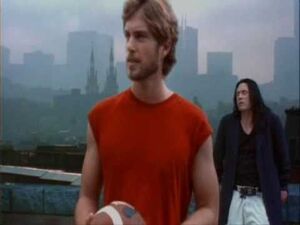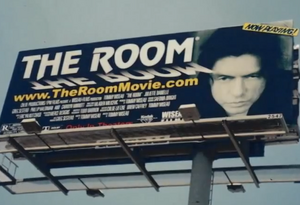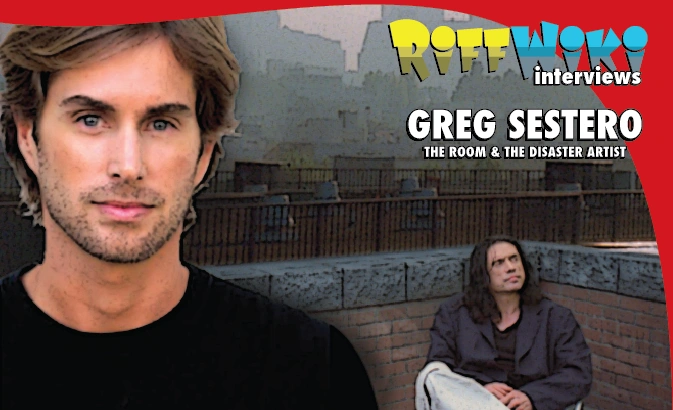This week we are interviewing the one and only Greg Sestero. Greg is known the world over for his performance as Mark in the cult film and RiffTrax cornerstone, The Room. His book about his experience making the film, The Disaster Artist: My Life Inside the Room, the Greatest Bad Movie Ever Made, is available now in hardcover and on digital platforms, and will be released in paperback on October 7.
RiffWiki: Lets go ahead and NOT start with something Wisaeu-related, because God knows there will be plenty of that forthcoming. Let's get to know Greg a little bit. How long have you been involved with performing? Was it always something you wanted to do, or was it a hobby or something that came into your life suddenly and without warning?

Greg Sestero: I loved movies growing up. I was always trying to incorporate my favorite scenes into my daily life. I once even tried to fool my dad that he’d time traveled. But it wasn’t until I saw Home Alone on Christmas day when I was 12 that I tried to do something with my obsession. I wrote a sequel to Home Alone titled Home Alone 2: Lost in Disney World (yeah, I know). I made sure it had a starring role for myself opposite Macaulay Culkin. Someone who could help him fight off the bandits. I submitted it to John Hughes Production Company and actually received a response from Hughes himself. Other than laughing at how bad my screenplay was, Hughes wrote me a very kind and encouraging note. It definitely pointed me in the direction of a creative pursuit.
RiffWiki: How exactly did you first meet Tommy Wiseau? (The non-Wiseau questions didn't last very long, sorry about that.)

GS: I was taking a nighttime acting class in San Francisco during the summer of 1998. It was held in a basement studio (“Perfect place for Vampire”—as Tommy would always say) It had been a rough class and everyone was ready to leave, including our teacher Jean Shelton. Tommy stood in the back row and made his way to the stage, picked around backstage for an uncomfortably long time. He then appeared, slammed a chair down onstage, and performed a Shakespearean sonnet. Everyone in that class knew we were witnessing the most beautifully, chaotic performance we would ever see. After watching him perform a scene from A Streetcar Names Desire the following week , I was intrigued. I had to find out who he was. So I approached him to be my next scene partner. His initial response was “Why you ask me?”
RiffWiki: You go over this quite extensively in The Disaster Artist, but for those who haven't picked it up yet and who totally should when the paperback comes out, give us the reader's digest version of how exactly you landed your role on The Room. Wasn't it already cast when you joined the production?

Art by Utah Graphics World
GS: Originally, I only agreed to help Tommy get his movie off the ground. It had been stalled for several months due to the fact that Tommy has a very particular way of working. To the uninitiated, the first instinct is to run. But once you get through the first couple blockades, Tommy has this berserker charisma. A childlike enthusiasm that is contagious. I’ve always been intrigued by characters, and respected passion. Tommy had them in spades. I understood and empathized with wanting to accomplish something no one believed you were capable of. So I started helping him set up auditions, meetings, rehearsals, find equipment. Basically, anything that needed to be done to help him get The Room made. When it came to his script, Tommy claimed to have written the role of Mark for me, but had to cast another actor in the role after I had politely declined having read the script. Then, the night before filming was finally set to commence, he demanded, “You have to do The Room. You will miss the boat. It will be big mistake.” Tommy was relentless. He went on about how the original “Mark” actor couldn’t properly perform the love scenes. I promised, under the Wiseauvian circumstances, I wouldn’t fair much better. He did assure me that my pants would stay on during the sex scenes and followed with an offer I couldn’t refuse. I reluctantly accepted, assuming no one would ever see the movie. It definitely made for an interesting first day on set.
RiffWiki: Again, something you go over extensively in the book, but give us the broad strokes of what was your day-to-day life like on the set of The Room. What was your attitude like going to work every day, and what was it like at the end of every day?

GS: It was my job to make sure Tommy got up and to the set by 8:00am. This would remain my job for the entirety of filming. It wound up being an adventure, considering Tommy’s nighttime schedule consisted of going to bed around 5:00am. On set, despite being a lead actor, I was also considered the Line Producer. At the time, I didn’t even know what that job consisted of. I later learned that an LP has to run the production, schedule call times, make sure people are paid, and organize food breaks. I sometimes had to interrupt scenes so I could order pizzas for the starving cast and crew. In regards to actually filming scenes, Tommy’s work was always the most entertaining. Watching him perform was what I looked forward to every day. I rarely even looked at my dialogue prior to shooting scenes. Tommy’s way of speaking is so catchy that I just pieced the dialogue together, picturing what he would say in those situations. One of my favorite things about Tommy’s original ‘Room’ script is every character talks exactly like him!
RiffWiki: At what point did you realize that The Room was blooming into what it has become, which is this inexplicable pop culture phenomenon?

GS: In an odd way, you could say, The Room rescued me. It hadn’t been a part of my life for several years. I’d been living Europe for a while, working in print and commercials. I’d just escaped getting killed in a bar scam in Istanbul, and returned to the U.S. To my surprise, I was contacted by Clark Collis--a Senior Writer at Entertainment Weekly—about doing a piece on The Room. He was captivated by his first theatrical experience and wanted to share it with the world. Clark ended up writing a 6 page article for EW that exposed the cult underground The Room had created. After the article, screenings began happening all over the world. In 2010, Tommy and I did an event at the Ziegfeld Theatre in NYC. It sold out 1,200 seats a week prior to the screening. One of the mangers of the theatre said it was the first film to do so since the re-release of Star Wars in 1997.
RiffWiki: How do you feel that a lot of your legacy as an actor will be determined by this movie?
GS: You have to start somewhere. Why it had to be this movie, I don’t know. I think everyone starts out hoping for Drive or Back To The Future. But, if appearing in The Room is what allows me to continue to be creative, then I’m grateful. You can, I hope, only head up from here. My focus is on the future, and The Disaster Artist is the first step in a new direction.
RiffWiki: Who's idea was writing a book about the whole experience? Was that yours or did somebody approach you about it?

THE DISASTER ARTIST My Life Inside THE ROOM, the Greatest Bad Movie Ever Made
GS: Whenever I’d share stories of my experiences with Tommy and making The Room, people always thought they were too crazy to be true. Apart from the insanity, I also thought the story behind The Room was weirdly inspiring. I remember seeing Tommy’s joy at a screening in 2005. He had been pushing the film for several years, keeping up a Hollywood billboard for over 5 years. At this particular screening, Over 180 people showed up. The audience was chanting his name, throwing spoons, quoting “You’re tearing me apart!” Afterwards, Tommy said he was so high on excitement, he couldn’t sleep for the next couple days. Regardless of how movie was perceived, I was happy for him. No one believed in The Room but he kept pushing and it finally found an audience. When the movie developed an international cult following several years later, I thought it was the perfect time to share the story behind the journey. I felt it was a universal story that could appeal to more than just fans of The Room. It’s a story about following your dreams, a very odd friendship and a surreal variation on the American Dream. As Tommy would say, “That’s life.”
RiffWiki: When did you first become aware of the existence of the RiffTrax commentary for the movie? Did you know about RiffTrax or Mystery Science Theater beforehand?

Rifftrax The Room - You are tearing me apart!-0
GS: I was a big fan of MST but didn’t know about the RiffTrax version until several ‘Room’ fans passed it along. I absolutely loved it! When I finished filming The Room, I showed the dailies and rough cut to my family and friends. They thought it was absolutely terrible, but couldn’t stop watching it. We all wondered what the normal, well tempered audience would think of the film, if it were to ever be released. When I saw the RiffTrax version, it was the experience I’d been waiting for 7 years.
RiffWiki: How did you react when you actually heard the RiffTrax commentary for the first time? Do you know what Wiseau or any of the other cast members reactions to it were?
GS: I know Tommy initially had objections to it, thinking RT had reshot the movie. But I explained to him what it actually was, and that having your film get a RiffTrax commentary was an honor. His retort was “Don’t pull my legs.” I’m pretty sure everyone involved with the movie found it hilarious.
RiffWiki: Have you partaken in any of the other RiffTrax commentaries? If so, what are your non-Room faves?

Rifftrax - Birdemic Sample-1
GS: I saw some of the Birdemic commentary and it was perfect. I definitely want to do a RT marathon. Mike Nelson, Kevin Murphy and Bill Corbett have a way of making anything entertaining.
RiffWiki: This is kind of a long shot, but it just popped into my head and I gotta ask, have you ever considered maybe trying your own hand at movie riffing? Like picking a bad movie, getting a couple of your pals together, writing some jokes and just letting fly at the badness of it? I think that would be something a lot of people would be interested in hearing. I know I would.
GS: That would be a lot of fun. I never even knew there was a thing for bad movies. I did have some films that I loved, for reasons unintended by its auteur. But The Room definitely opened me up to the appeal of bad movies. There’s something invigorating about watching someone shoot for the stars and ending up with a drastically different result.

RiffWiki: So, lastly, are there any projects on the horizon that you're excited about that you'd like to share with us? What's up next in the life of Greg Sestero?
GS: I recently wrapped a horror-comedy movie from the creators of 5 Second Films called Dude Bro Party Massacre III. It also stars Patton Oswalt and Andrew WK. It was refreshing to work on something new. I definitely want to make more films. I’m interested in roles I’ve never tried or thought I’d try. And I’d definitely love to write more.
RiffWiki: Thanks so much for talking to us today, we can't thank you enough for it.
GS: Thank you!
The Disaster Artist is available in paperback on October 7th, 2014. Click here to reserve or buy your copy. The riff for The Room is available at RiffTrax.com, and the movie itself is available for purchase on Amazon.

